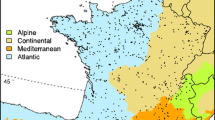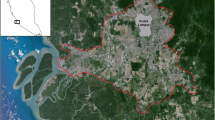Abstract
In Britain, much emphasis has been placed on conserving butterfly species in specialized habitats, since this is where most of it‘s threatened butterflies exist, whilst the wider countryside has been largely overlooked. However, there is increasing awareness that small improvements to the dominant landscape could potentially reap huge benefits to the populations of many of Britain‘s butterfly species. Recent studies have also stressed the importance of the landscape scale in the conservation of butterflies in small fragmented habitats. In this paper, we examine data from a variety of sources and conclude that the importance of shelter in open landscapes may be underestimated since recording is often restricted to the optimum conditions suggested by the Butterfly Monitoring Scheme. In less favourable conditions, butterflies may place greater reliance on those components of the landscape offering shelter. In light of the current policy of agricultural de-intensification we discuss how modifications to our current landscapes could benefit a wide range of species.
Similar content being viewed by others
References
Anon (1995) Biodiversity: The UK Steering Group Report. London: HMSO.
Barr, C.J. and Parr, T.W. (1994) Hedgerows: linking ecological research and countryside policy. In Hedgerow management and nature conservation(T.A. Watt and G.P. Buckley, eds), pp. 119–36. Wye: Wye College Press.
Countryside Commission (1984) Agricultural Landscapes. A Second Look. Cheltenham: Countryside Commission.
Dennis, R.L.H. (1986) Motorways and cross movements. An insect’s ‘mental map’ of the M56 in Cheshire. Bull. Am. Entomol. Soc. 45, 228–43.
Dennis, R.L.H. (ed) (1992). The ecology of butterflies in Britain. Oxford: Oxford University Press.
Dover J.W. (1989). The use of flowers by butterflies foraging in cereal field margins. Entomol. Gaz. 40, 283–91.
Dover, J.W. (1990) Butterflies and wildlife corridors. Game Conservancy Review 21, 62–4.
Dover, J.W. (1991) The conservation of insects on arable farmland. In The conservation of insects and their habitats. (N.M. Collins and J.A. Thomas, eds). London: Academic Press.
Dover, J.W. (1994) Arable field margins: factors affecting butterfly distribution and abundance. In Field margins: integrating agriculture and conservation(N.D. Boatman, ed.) pp.59–66. Farnham: BCPC.
Dover, J.W. (1996). Factors affecting the distribution of satyrid butterflies on arable farmland. J. App. Ecol. 33, 723–34.
Dover, J.W., Clarke, S.A. and Rew, L. (1992) Habitats and movement patterns of satyrid butterflies (Lepidoptera: Satyridae) on arable farmland. Entomol. Gaz. 43, 29–44.
Feber, R.E., Smith, H. and Macdonald, D.W. (1994) The effect of field margin restoration on the meadow brown butterfly (Maniola jurtina). In Field margins: integrating agriculture and conservation(N.D. Boatman, ed.) pp.295–300. Farnham: BCPC.
Fry, G.L.A. and Robson, W.J. (1994) The effects of field margins on butterfly movement. In Field margins: integrating agriculture and conservation(N.D. Boatman, ed.) pp.111–16. Farnham: BCPC.
Hanski, I. and Thomas, C.D. (1994) Metapopulation dynamics and conservation: a spatially explicit model applied to butterflies. Biol. Conserv. 68, 167–80.
Munguira, M.L. and Thomas, J.A. (1992) Use of road verges by butterfly and burnet populations, and the effects of roads on adult dispersal and mortality. J. Appl. Ecol. 29, 316–29.
Pollard, E., Hall, M.L. and Bibby, T.J. (1986). Monitoring the abundance of butterflies 1976–1985. Peterborough: Nature Conservancy Council.
Rands, M.R.W. and Sotherton, N.W. (1986). Pesticide use on cereal crops and changes in the abundance of butterflies on arable farmland in England. Biol. Conserv. 36, 71–82.
Sparks, T.H. and Parish, T. (1995) Factors affecting the abundance of butterflies in field boundaries in Swavesey fens, Cambridgeshire, UK. Biol. Conserv. 73, 221–27.
Sparks, T.H., Bellamy, P.E., Eversham, B.C., Greatorex-Davies, J.N., Hinsley, S.A., Jones, S.A. and Mountford, J.O. (1996) The effects of three hedge management treatments on the wildlife of a Cambridgeshire hedgerow. Aspects of Applied Biology 44, 277–84.
Warren, M.S. (1992a) The conservation of British butterflies. In The ecology of butterflies in Britain(R.L.H. Dennis, ed.) pp. 246–74. Oxford: Oxford University Press.
Warren, M.S. (1992b) Butterfly populations. In The ecology of butterflies in Britain(R.L.H. Dennis, ed.) pp. 73–92. Oxford: Oxford University Press.
Author information
Authors and Affiliations
Rights and permissions
About this article
Cite this article
Dover , J., Sparks , T. & Greatorex-Davies , J. The importance of shelter for butterflies in open landscapes. Journal of Insect Conservation 1, 89–97 (1997). https://doi.org/10.1023/A:1018487127174
Issue Date:
DOI: https://doi.org/10.1023/A:1018487127174




